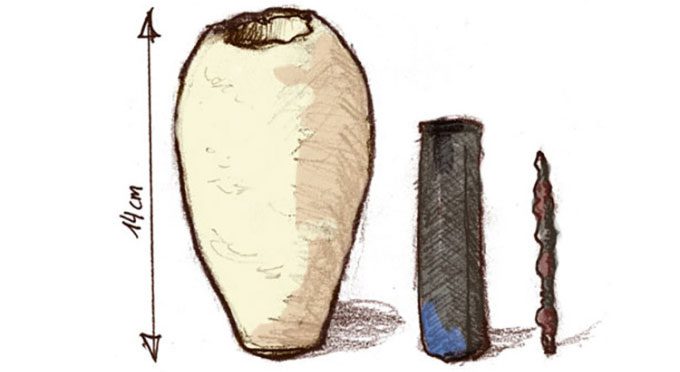An ancient clay jar, containing an iron rod located within a cylindrical copper tube, has the potential to generate an electric current of 1.5 – 2 volts, leading to speculation that it could be an ancient type of battery.
In 1938, German archaeologist Wilhelm König discovered an ancient clay jar in Khujut Rabu, southeast of Baghdad. The jar was sealed with a plug made of a material resembling asphalt. However, scientists were more intrigued by the contents inside: an iron rod within a cylindrical copper tube.

Illustration of the three components of the “Baghdad Battery”. (Image: Wikimedia).
König was the first to suggest that the jar was used as a form of ancient battery, 1,800 years before the first actual battery was invented. After World War II, engineer Willard Grey experimented by filling a replica of the Baghdad Battery with grape juice. He found that it could generate an electric current of 1.5 – 2 volts, which, while not significant, was still a form of electric charge. Subsequent experiments confirmed that the device could produce energy if the owner had the necessary knowledge and materials.
The fact that the jar could generate an electric charge does not necessarily mean this is how it was used 2,000 years ago. The accuracy of this timeframe is still debated, as many questions surround the dating of the jar. Some experts suggest it dates back to around 225 AD.
It is possible that the Parthians (or the Sassanians if the jar indeed dates back to 225 AD) were aware of the jar’s effects (for example, experiencing a mild shock) without understanding the mechanism or cause. Dr. Paul Craddock, a metallurgy expert at the British Museum, proposed a curious hypothesis that the ancients might have used the jar to “trick” people in a temple.
“It could be connected to a statue of a deity, and then the priest would pose questions. If answered incorrectly, you would touch the statue and receive a mild shock, possibly accompanied by a mysterious blue flash. Answer correctly, and the trickster or priest could disconnect the battery, and you would not be shocked. Thus, you would be convinced of the statue’s power, the priest, and the religion,” Craddock stated.
Experts have not found any other artifacts similar to the Baghdad Battery in the region, meaning that if the ancients truly understood batteries, proponents of this hypothesis must explain why this knowledge did not spread.
Another perhaps more plausible explanation is that the jar was used to store scrolls, as it resembles containers found in the nearby region of Seleucia. Professor Elizabeth Stone, an expert in Iraqi archaeology, stated in 2012 that none of the archaeologists she knows believe the jar is a battery. However, it was stolen from the National Museum of Iraq during the war with the U.S. in 2003, making further research impossible.


















































